Providers
Webinar: Unlocking Efficiency & Accuracy with RTM Billing AutomationJoin Limber Health and Raintree Systems' on-demand webinar, hosted by industry experts, to learn how automated RTM billing can boost revenue and reduce staff workload. Discover CPT code essentials, billing nuances, and best practices for revenue cycle management tailored for physical therapy practices.



.png)
.png)

.png)



